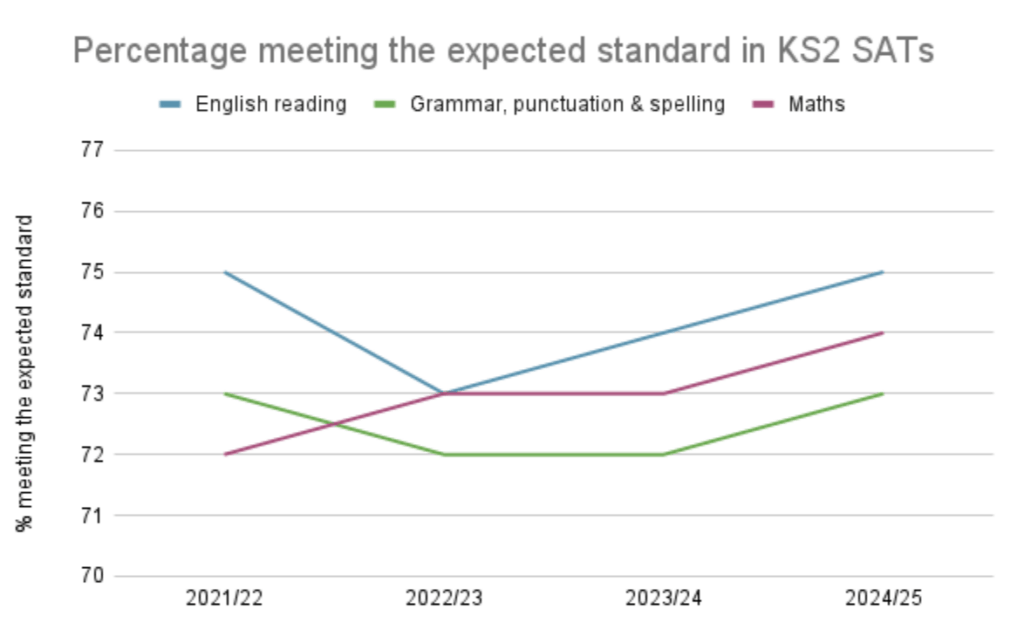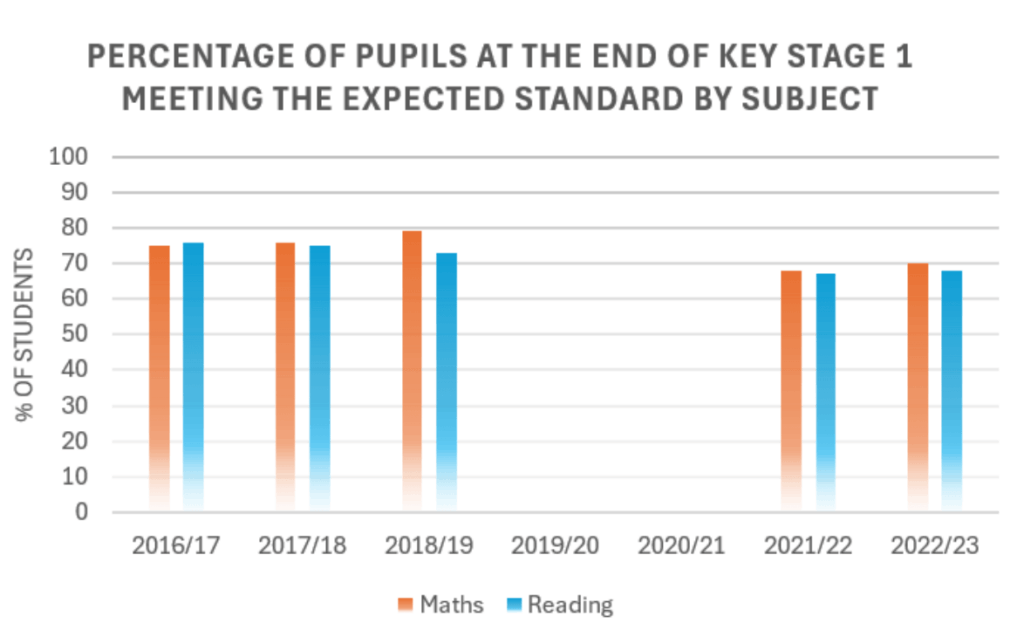

Learn everything you need to know about SATs results 2026 including KS1 & KS2 results and how SATs results are scored.

Author
Mhairi Sim
Updated
November 2025


Learn everything you need to know about SATs results 2026 including KS1 & KS2 results and how SATs results are scored.

Author
Mhairi Sim
Updated
November 2026


Learn everything you need to know about SATs results 2026 including KS1 & KS2 results and how SATs results are scored.

Author
Mhairi Sim
Updated
November 2025


Key takeaways
The KS1 and KS2 SATs have long been a key event in primary school calendars across England! These assessments test students on the national curriculum as they reach the end of their current stage before they move on to the following school year.
After sitting the SAT papers themselves, one of the most nerve-wracking parts of these assessments is awaiting the SATs results day! Students, parents, and teachers all look to the SATs scores to see if their learners are where they’re expected to be in their learning journey.
In this guide, we’ll explore how KS1 and KS2 SATs are marked, what the scores mean for our kiddos, and highlight important results dates for your diary!
Let’s take a look at the key SATs results 2026 dates you need for your diary below!
The KS1 SATs are not mandatory assessments, so each school decides if its Year 2 students will take part.
In addition, this means that schools are also no longer obliged to report the results of these assessments to the Department for Education. The results of the KS1 SATs are for the school’s internal use only.
The first date you need to know for the Year 6 SATs results 2026 is Tuesday 7th July 2026. This is the date that each student’s scores were made available online for schools to view.
These results will be released to parents shortly, but definitely before the end of the summer term. The Department for Education’s KS2 attainment page has now also been updated with the headline facts and figures about what the 2025 results tell us about the assessment as a whole.
Later this year, in mid-December, the primary school performance table for 2025 will be published. These tables show how schools performed against others across the county in their KS2 SAT scores.
Unlock unlimited maths questions
Put your learning into practice with fun exercises + games that are proven to boost ability!
Looking for more SATs practice? DoodleLearning is an award-winning maths and English app that’s filled with thousands of questions and games aligned to the national curriculum!
Designed by teachers, it creates each child a unique work programme tailored to their needs, doubling their progression with just 10 minutes of use a day.* Try it for free!

*Based on earning 24 stars a day in DoodleMaths. Read full study

The results are in! Now that the SATs results 2025 are available, let’s take a closer look at them and how they compare to previous years.
The table below shows the percentage of students whose results met the expected standard in the KS2 SATs over the last six years of assessments. Results can be seen for each of the formally assessed areas, including maths, English reading, and grammar, punctuation and spelling.

Here’s a closer look at the Year 6 SATs results 2025, showing the changes from the previous year:
| Subject/Paper | 2023/24 | 2024/25 | % increase/decrease |
|---|---|---|---|
| English reading | 74% | 75% | ↑ 1% |
| Grammar, punctuation & spelling | 72% | 73% | ↑ 1% |
| Maths | 73% | 74% | ↑ 1% |
The KS1 SATs results are not reported in the same way as the KS2 results. Results are not reported to local authorities or the government, so there are no published figures on nationwide performance.
If a school had its Year 2 students sit the KS1 SATs, results may be reported to parents, though there is no obligation for the school to do so. If your little one sat this assessment and you haven’t received results, you could reach out to your child’s teacher to ask how they did!
Maths and English reading are two areas of the KS1 SATs results that were reported previously. We’ve collated the last five assessments’ worth of scores, which were reported in the graph below, including the maths and English KS1 SATs scaled scores for the final reporting year, 2023.

The marking process for the KS1 and KS2 SATs differs due to the recent decision to make KS1 SATs optional assessments. KS1 SATs are therefore now marked in-house by teachers who are familiar with the students.
KS2 SATs are sent out of schools for external marking by specially trained SAT markers. The results are then available online for schools later in the year.
SAT exam scores are reported using scaled scores, but what exactly are scaled scores? Put simply, they’re a way of adjusting scores each year, taking into consideration the difficulty of the paper, to make like-for-like comparisons between yearly results.
Scaled scores are calculated using a table which is released each year. This table allows markers to equate a ‘raw score’ (or the actual number of correct marks achieved) to a scaled score.
The range of scaled scores that are awarded differs for each Key Stage assessment:
In each Key Stage SAT, the scores are used to determine if students are working at the expected level for their year group. A score of 100 or more would indicate that a pupil is right on track!
Scores of 99 or less suggest that a student might benefit from some additional support as they progress onto the next year group and key stage.
In each Key Stage SAT the scores are used to determine if students are working at the expected level for their year group. A score of 100 or more would indicate that a pupil is right on track!
Scores of 99 or less would tend to suggest that a student might benefit from some additional support as they progress onto the next year group and key stage.
SATs results are simply a way for schools to assess if a learner is where they’re expected to be at each stage of their learning journey. The scaled score informs their teacher next year whether they may need a little extra help (or challenge if their score is high!) as they move on.
There are no ‘passes’ or ‘fails’ here, just an opportunity to get the right support in place to ensure your learner is progressing!
If you have a Year 2 or Year 6 student with their SATs on the horizon, you may begin preparing them with some extra revision or practice! Let your learners try out our fantastic Doodle Learning maths app and English app, and we’re sure they’ll love it!
The apps have thousands of fun curriculum-linked games and activities that they’ll enjoy so much, they won’t even realise they’re revising! What better way to get them prepared and ready to take on their SATs?!
Try DoodleMaths for free!
Select a year group
It is up to individual schools to release pupils’ SAT scores to parents, and there is no other way to view these.
It’s worth noting that if your child sits the KS1 SATs, the school are not obligated to release the results, but you can request them.
For Year 6 students who have completed their KS2 SATs, their results are now available online for schools. These scores will then be shared with parents before the end of the summer term.
If you have a Year 2 or Year 6 student who has their SATs on the horizon then you may want to help prepare them with some extra revision or practice! Let your learners try out our fantastic Doodle Learning maths app and English app and we’re sure they’ll love it!
The apps have thousands of fun curriculum-linked games and activities that they’ll enjoy so much, they’ll not even realise they’re revising! What better way to get them prepared and ready to take on their SATs?!
SAT scores of 100 or more indicate that a learner is performing at or above the expected level for their year group. This applies to both KS1 and KS2 SAT scoring.
To reach a scaled score, learners’ raw score (or the total mark they achieved in the paper) is converted using a scoring table like this one which was used in 2023.
The raw score is converted into a scaled score which makes it easier to compare the results of the SATs from year to year. This is because scaled scores take into account the difficulty of the paper and the performance of a year group overall.
The only average SAT scores which are reported are those for the KS2 SATs. The average KS2 SATs scaled scores 2023 are as follows and have remained the same for the last two years:
The highest score that can be achieved in the KS1 SATs is 115, and the highest score for the KS2 SATs is 120.
The Key Stage 1 SATs scaled score range is from 85 to 115.
The Key Stage 2 SATs scaled score range is from 80 to 1.
Lesson credits

Mhairi Sim
Mhairi is an experienced teacher, freelance writer and parent. After completing her bachelor's degree in Psychology, she graduated as a teacher from the University of Strathclyde. She then built experience teaching across KS1 and KS2 throughout the UK. In addition to working in mainstream education, Mhairi specialised in the additional support needs sector, including social, emotional, and behavioural support.

Mhairi
Mhairi is an experienced teacher, freelance writer and parent. After completing her bachelor's degree in Psychology, she graduated as a teacher from the University of Strathclyde. She then built experience teaching across KS1 and KS2 throughout the UK. In addition to working in mainstream education, Mhairi specialised in the additional support needs sector, including social, emotional, and behavioural support.
Book a chat with our team
If you’d like to use Doodle’s browser version, please visit this page on a desktop.
To log in to Doodle on this device, you can do so through our apps. You can find out how to download them here: